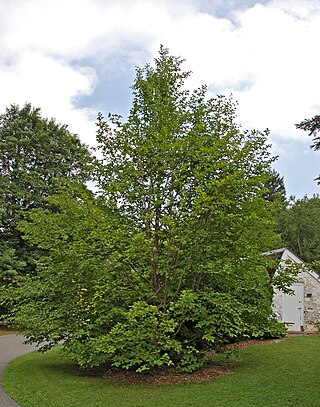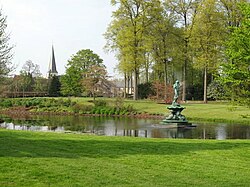
An arboretum is a botanical collection composed exclusively of trees of a variety of species. Originally mostly created as a section in a larger garden or park for specimens of mostly non-local species, many modern arboreta are in botanical gardens as living collections of woody plants and is intended at least in part for scientific study.

The Bartlett Arboretum and Gardens in Stamford, Connecticut, contains 93 acres of parkland, gardens, landscapes, and hiking trails that focus on the regional plants, ecology and character of Southwestern New England. The Arboretum is open and accessible to the public every day of the year and is located at 151 Brookdale Road.

The Connecticut College Arboretum is a 300 ha arboretum and botanical gardens, founded in 1931, and located on the campus of Connecticut College and in the towns of New London and Waterford, Connecticut, United States.
Mountain Top Arboretum, located in Tannersville, New York, United States is located in New York's Catskill Mountains.

The Holden Arboretum, in Kirtland, Ohio, is one of the largest arboreta and botanical gardens in the United States, with more than 3,600 acres (1,500 ha), including 600 acres (240 ha) devoted to collections and gardens. Diverse natural areas and ecologically sensitive habitats make up the rest of the holdings. Holden's collections includes 9,400 different kinds of woody plants, representing 79 plant families.

The Donald E. Davis Arboretum, in Auburn, Alabama, United States, is a public native plants museum, and botanical arboretum with educational facilities, event spaces, and a conservation program. Its grounds, covering 13.5 acres of Auburn University's campus, include cataloged living collections of associated tree and plant communities representative of Alabama's ecosystems, among which is mixed oak forest, carnivorous bog, and longleaf pine savanna. The living collections include more than 1,000 plant types, including 500 different plant species, with over 3,000 cataloged specimens. The Arboretum contains over a mile (2 km) of interwoven walking trails that meander through various southeastern biotopes.
University of Nevada, Reno Arboretum is a state arboretum located across the campus at the University of Nevada, Reno in Reno, Nevada.

Bailey Arboretum is a 42-acre (17 ha) arboretum located in Lattingtown, New York, a small village on the North Shore of Long Island. It opened to the public on Aug. 5, 1969 after being donated to Nassau County in 1968 by the heirs of Mr. and Mrs. Frank Bailey. Through an agreement with the Village of Lattingtown, admission to the arboretum was limited to 200 people at any one time.

Nichols Arboretum, locally known as the Arb, is an arboretum operated by the Matthaei Botanical Gardens and Nichols Arboretum (MBGNA) at the University of Michigan. Located on the eastern edge of its Central Campus at 1610 Washington Heights in Ann Arbor, Michigan, the Arboretum is a mosaic of University and City properties operated as one unit. The arboretum is open daily from sunrise to sunset with no charge for admission. The Huron River separates a northern section of the arboretum's floodplain woods; the railroad marks the northern border.

Tyler Arboretum is a nonprofit arboretum located at 515 Painter Road, Middletown Township, Delaware County, Pennsylvania. It is open daily except for major holidays; an admission fee is charged to non-members.
The Plant Collections Network (PCN) is a group of North American botanical gardens and arboreta that coordinates a continent-wide approach to plant germplasm preservation, and promotes excellence in plant collections management. The program is administered by the American Public Gardens Association from its headquarters in Kennett Square, Pennsylvania, in collaboration with the USDA Agricultural Research Service.

The University of Guelph Arboretum is an arboretum organized by the University of Guelph in Guelph, Ontario. It was formally established in 1970 by the university and aims to conserve biodiversity and connect people with nature through teaching, research, and community outreach. The space is 165 hectares and is open throughout the year.

The Sir Harold Hillier Gardens is an arboretum comprising 72 hectares accommodating over 42,000 trees and shrubs in about 12,000 taxa, notably a collection of oaks, camellia, magnolia and rhododendron.

Stewartia pseudocamellia, also known as Korean stewartia, Japanese stewartia, or deciduous camellia, is a species of flowering plant in the family Theaceae, native to Japan and Korea.
Viscount Philippe de Spoelberch is a Belgian businessman and dendrologist.
The Arboretum du Chêne-Vert is a private arboretum located just off the Route de Limoges in Chabanais, Charente, Nouvelle-Aquitaine, France. It is open daily by appointment; an admission fee is charged.
The Poërop Arboretum is a 22-hectare arboretum located in Huelgoat, Finistère, Brittany, France.

The Arboretum national des Barres is a national arboretum located in Nogent-sur-Vernisson, Loiret, Centre-Val de Loire, France. It is open daily in the warmer months; an admission fee is charged. Closure is planned for the end of year 2018 because subsidy from local and national government is too short.

Wojsławice Arboretum is an arboretum, located in Wojsławice, Dzierżoniów County, Lower Silesian Voivodeship, in south-western Poland. It occupies an area of 62 ha.
ArbNet is an international arboretum accreditation and networking program. The ArbNet program is supported and coordinated through The Morton Arboretum, with partners American Public Gardens Association and Botanic Gardens Conservation International. ArbNet was developed to set industry standards, foster partnerships and collaborations, and provide guidelines for professional development for tree-focused gardens. Globally, over 150 arboreta have been accredited since 2011. There are four different levels of accreditation depending on the arboretum's stage of development, capacity, and potential for scientific and conservation-related collaboration. All levels require a strategic plan, a focus on woody species, public access, and participation in the ArbNet community. Level I arboreta achieve a basic level of accreditation whereas Level IV arboreta reach the highest level of arboretum standards.















